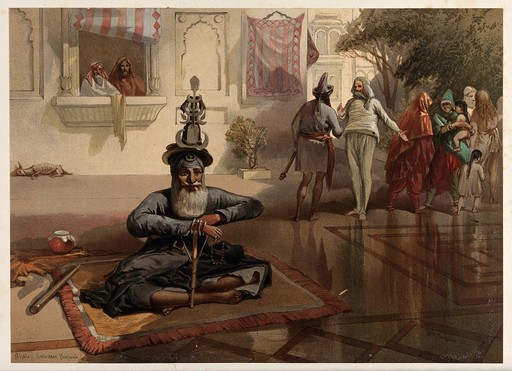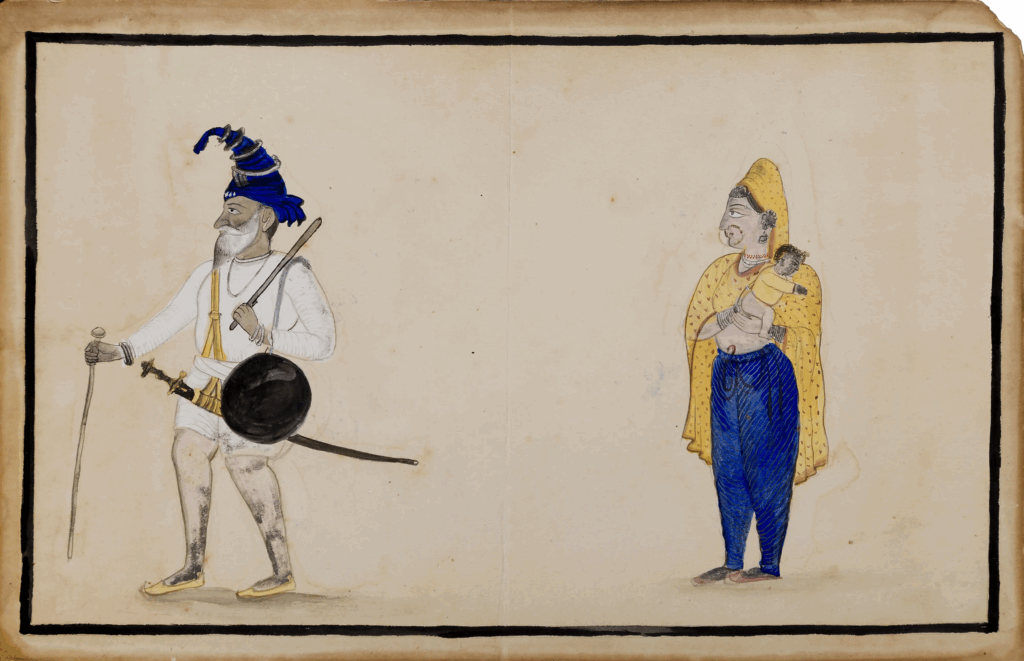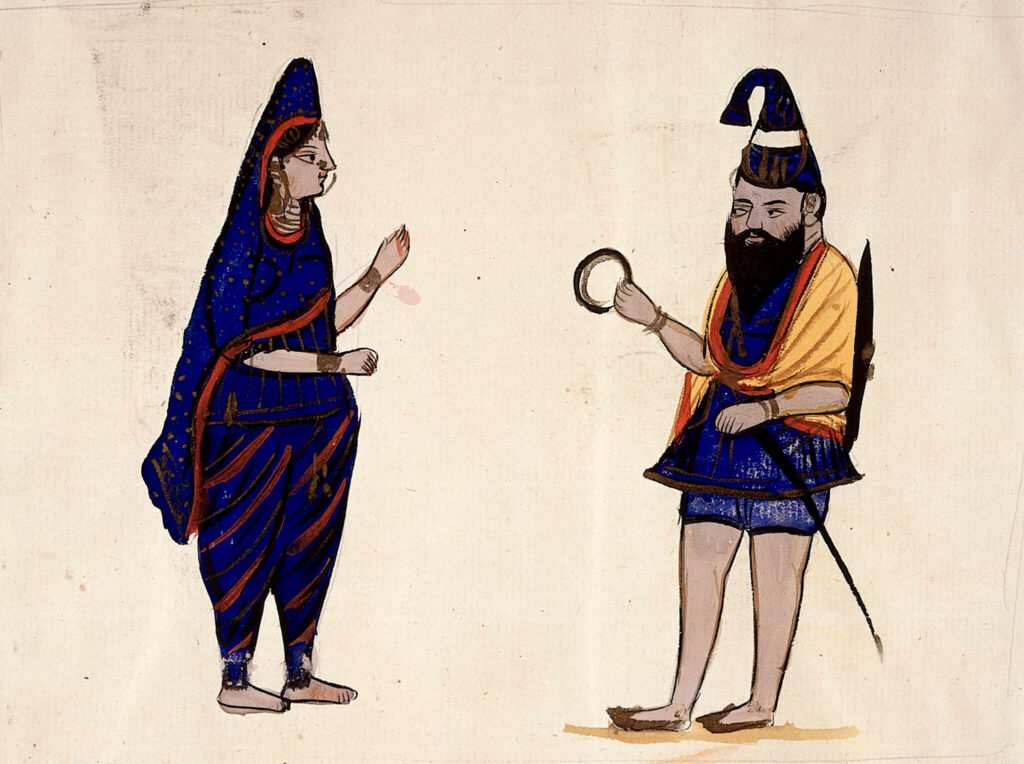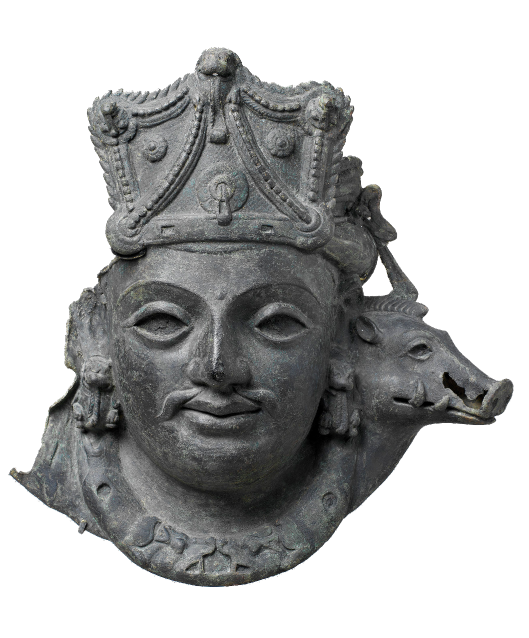PERSPECTIVES
Wife, Mother, Warrior: Female Akalis in Colonial Art
In nineteenth century colonial Punjab, Major Robert Leech, a British officer serving as the Assistant Agent to the Governor General in Ambala, was tasked with documenting the Sikh community in the region. It was then that he encountered the Akali Nihang Singhs — members of the feared religious warrior order with a reputation for being fierce fighters. Later, in his Notes on the Religion of the Sikhs and Other Sects Inhabiting the Punjab (1845), he would write, “They [the Akali Nihang Singhs] are the fanatics of the Sikh religion — literally covering themselves with iron, generally wearing, besides 2 swords at their side, from 1 to 7 quoits (metal discuses) on their turbans which they make very high by means of a knife stuck in the centre, and an iron chain wound round. They stick 3 or 4 more knives in their turbans, and have, generally, a spear, besides several daggers in their waist-band. Their women are also armed like the men, and are said to be expert horsemen — and to be able to make good use of these arms when required.”
Renowned for their striking blue attire, the Akali Nihang Singhs traced their origins to the time of the tenth Sikh Guru in the last quarter of the 17th century. This was when Guru Gobind Singh Sahib founded the Khalsa panth, a new spiritually “pure” order of warrior Sikhs. The Akali Nihang Singhs became the committed warriors of the Khalsa panth, following a specific dress code and wearing a special kind of tall, pyramidal turban. The women, married to male members of the order, also knew how to fight, wielding both traditional weapons like the katar, the sword, and later, modern arms like pistols.

In the 1843 edition of the Foreign Missionary Chronicle, a Christian missionary, Reverend J Caldwell, stationed in Meerut, Uttar Pradesh, described his encounter with a female Akali. “We were visited this forenoon by a most singular character, an Akalin, or female faqir of a particular sect. Like the class of mendicants to whom she belongs, she was armed to the teeth. Over her shoulder was slung a sword, while her belt was graced with a large horse pistol, a dagger, and sundry other weapons of destruction. Another sword hung by her side. Her turban was ornamented with a panji and five or six chakkars. The panji is a horrid instrument made something in form of tiger’s claws, with five curved blades exceedingly sharp. The chakkar is a steel discus, of six or eight inches diametre, very sharp also, and no doubt a destructive weapon when hurled with sufficient force. She was, certainly, the most dangerous looking lady I ever saw…”
Not surprisingly, the warrior sect captured the imagination of colonial artists and their audiences as well. While most paintings from this period depict male Akalis, some also portray female Akalis, or the “Akalan,” primarily through the medium of watercolours and gouaches. The representation of Akali families — constituting male and female Akalis with their children — indicated that military traditions were passed down, from parents to their children, in the warrior order. These artworks were part of Company-style albums, but several paintings were also independently produced by British artists like Emily Eden (1797-1869).

Colonial period representations of female Akalis often downplayed military or religious contexts, preferring to show them in domestic roles — as housewives and mothers — who played a central role in bringing up the next generation of warrior Sikhs. It is interesting to note that though the Akalan often carried the same weapons as her male counterpart, such as quoits — metal discuses thrown at targets during battles — as described in many British colonial accounts, their paintings seldom reflected this.
It is rare to find images of an individual Akalan from the colonial period because they were almost always accompanied by their husband or children. They were also featured far more infrequently, as compared to male Akalis, in Company-style albums. While the marital status of the Akalan was only implied in these visual representations, they were often shown in maternal poses, taking care of their children.

The Akalans were occasionally depicted in blue clothing, in keeping with the warrior sect’s dress code for male members, along with the signature conical headwear or ‘top-knots’ in place of the male Akalis’ dastar boonga turbans.
In one of Eden’s watercolours, an Akali Nihang woman sits atop a horse wearing a blue turban that is comparable in height to her husband’s. This is in contrast to the top-knot style observed in Company-style depictions of the Akalan, which could suggest that not all female Akalis were warriors. In most cases, the attire of the female Akali, in visual representations, lacked many of the signature characteristics of the male Akali’s clothing. It was also not unusual for visual discrepancies to creep into Company-style illustrations. For instance, the Akalan’s conical headwear — that mirrored the turbans of male Akalis — looks more rounded with a white shawl-like covering in one painting.

architecture, trades and occupations); Unknown Artist; Punjab; 1860; Watercolours on pen and ink drawing. Courtesy The Trustees of the British Museum
Eden’s painting is one of the only known works where the Akalan is fully dressed and armed, in a way that reflects primary colonial accounts. Company-style representations, however, featured them as unarmed companions of male Akalis. Typical visual representations of Akali families often featured new-born infants clinging to their mothers, emphasising the child-rearing, maternal duties of the Akalan.
Eden’s watercolour is the exception to the rule — with the child Akali in her work shown with weaponry, and depicted as a grown adolescent boy — shifting the focus to the Akalan’s warrior role over her maternal one. It is also particularly significant that the Akalan appears on horseback in Eden’s portrayal, almost lessening the military role of the male Akali in the painting, who is on foot. This is another way her work deviates from the more common imagery of Akalis in the mid-nineteenth century, where only male Akali military leaders were viewed on horseback, surrounded by other Akalis on foot.
Eden’s visual representation of the Akalan on horseback reinforced the martial aspect of her role in the warrior sect, parallel to the male Akali. The landscape depicting the Punjab plains as a backdrop visually references the imperial picturesque, which was a common subject amongst British artists in India. Therefore, the presence of the Akali family within this setting could be seen as a form of exoticization of the region and its inhabitants.
But the accounts by Leech and Caldwell, in part, substantiate the accuracy of Eden’s visual representation of the Akalan as does the observation of another European — Irishman George Thomas (1756–1802) — who led military campaigns in 18th-century India. He notes, in the Military Memoirs of Mr. George Thomas (1805), “Instances indeed, have not infrequently occurred, in which they (female Akalis) have actually taken up arms to defend their habitations, from the desultory attacks of the enemy, and throughout the contest, behaved themselves with an intrepidity of spirit highly praise-worthy.”
Another primary account, by Major Moyle Sherer (1789-1869), notes the attractive appearance of the Akalans while passing through the city of Bidar in 1818. He describes their ornament-filled robes and admires their “fine forms.” This ornamentation could possibly refer to weaponry, although this is not known. But, overall, while we do have textual accounts of the female Akalis’ fighting abilities, it could be argued that the martial Sikh female body remained largely unknown in artistic representations.

The fleeting nature of even the textual accounts, written during travels, suggest a superficial engagement with the Akalans. Significantly, this is in direct contrast with the amount of attention that the armed male Akalis attracted during the colonial period, in both textual descriptions and imagery. Seen as a threat, they were often referred to as “insolent,” “turbulent,” and “fanatics,” in primary accounts by colonial officials such as Sir John Malcom (1769-1833).
Some Company albums with watercolour paintings of Akali couples bear revealing inscriptions too. Notably, one inscription for a watercolour image of an Akali and his wife refers to the Akali as a “bluebeard,” a phrase implying that Akalis married and killed their wives in succession. However, there is no evidence in primary accounts to substantiate this.
The use of watercolours to make portraits was a common practice among European travellers, missionaries, and colonial artists during the eighteenth and nineteenth centuries. The medium could have arguably been used to give the Akalans a more distinct identity in visual renditions, emphasising their personhood through the depiction of intricate clothing and weaponry, using fine brushes and the translucence of watercolour paints. The smaller number of works featuring them highlights that the Akalans were largely ignored in favour of their male counterparts by colonial artists. The few depictions of female Akalis, in a mostly maternal context, softened colonial perceptions about the sect. But, at the same time, textual accounts of their fierceness deepened the mystery surrounding the Nihang Akalis and their customs, especially their familial martial traditions, which became subjects of debate and discussion for colonial authorities.
Tanya Mascarenhas is an art historian and writer. She holds a Master’s degree in Art History focusing on nineteenth century colonial South Asia from The Courtauld Institute of Art, London.




